


既有适合小白学习的零基础资料,也有适合3年以上经验的小伙伴深入学习提升的进阶课程,涵盖了95%以上大数据知识点,真正体系化!
由于文件比较多,这里只是将部分目录截图出来,全套包含大厂面经、学习笔记、源码讲义、实战项目、大纲路线、讲解视频,并且后续会持续更新
String s = null;
// NullPointerException: 空指针异常(用 null 调用方法)
int len = s.length();
}
}
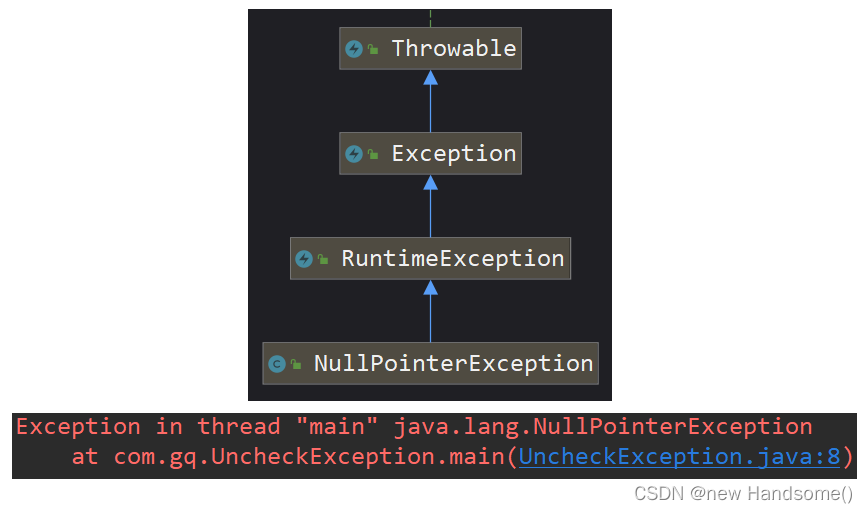
#### ④ NumberFormatException【RuntimeException】
**NumberFormatException: 数字格式化异常**
public class UncheckException {
public static void main(String[] args) {
/*
Integer.parseInt(): 把字符串转换为数字
NumberFormatException: 数字格式化异常
原因:句子不能转换为数字
*/
int i = Integer.parseInt(“你点赞了吗?”);
}
}
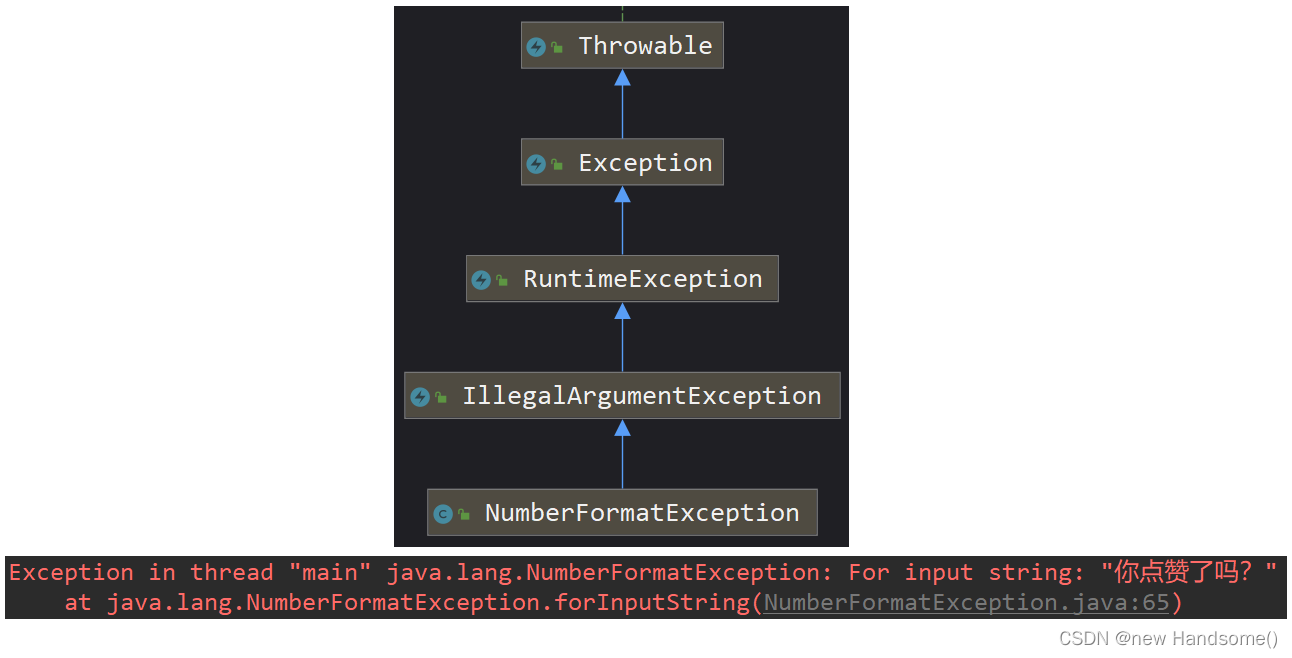
#### ⑤ ArrayIndexOutOfBoundsException【RuntimeException】
**ArrayIndexOutOfBoundsException: 数组索引越界异常**
public class UncheckException {
public static void main(String[] args) {
int[] ints = new int[3];
// ArrayIndexOutOfBoundsException: 数组越界异常
System.out.println(ints[66]);
}
}
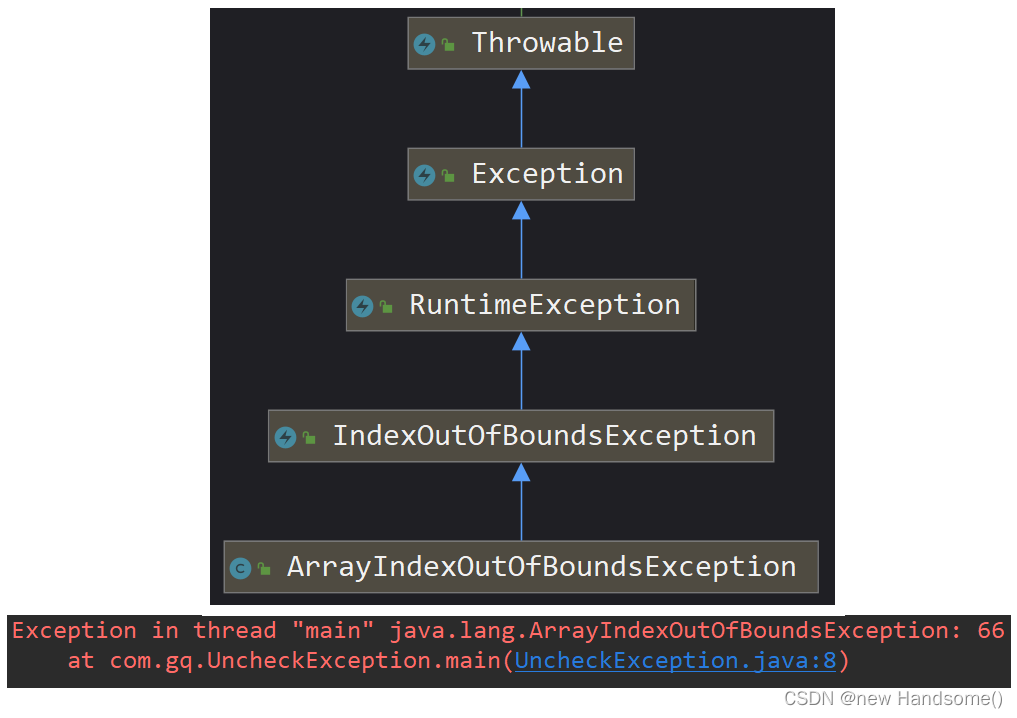
#### ⑥ ClassCastException【RuntimeException】
**ClassCastException : 类型转换异常**
public class UncheckException {
public static void main(String[] args) {
Object o = 3.14F;
// ClassCastException 类型转换异常
int i = (int) o;
}
}
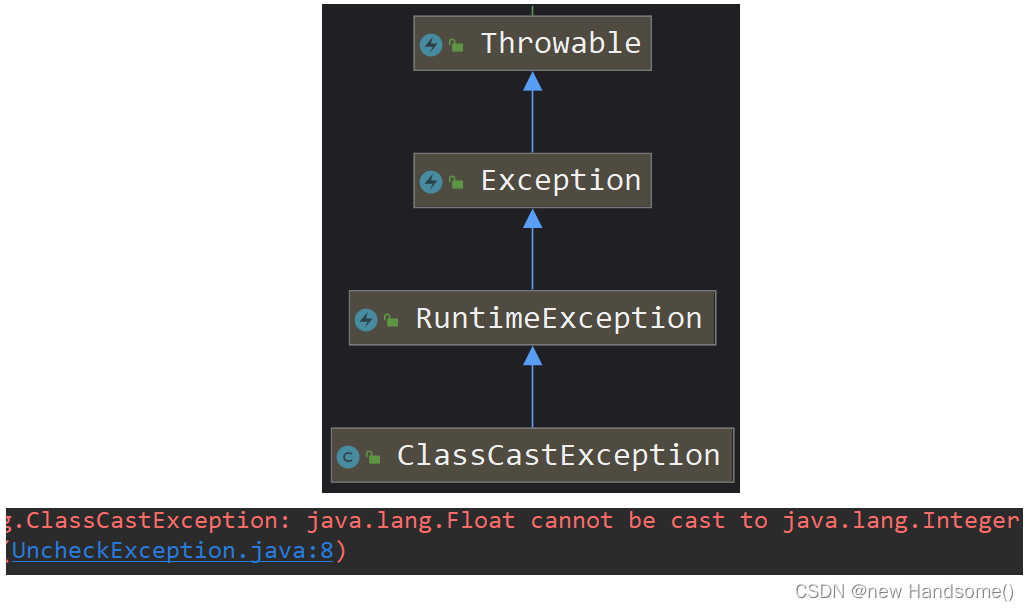
## 三、try-catch 处理异常
📜 程序产生了异常,有个专业的术语:抛出了异常
📜 无论是检查型异常,还是非检查型异常,只要开发者没有主动去处理它,都会导致 Java 程序终止运行
📜 处理异常有**2**种方式:
>
> ✒️ ① `try-catch`【捕获异常】
> ✒️ ② `throws`【往上抛异常】
>
>
>

### (1) try-catch
📜 可能抛出异常的代码放`try`代码块中
📜 `catch`代码块用于捕获不同类型的异常,并对异常做出处理
>
> 🌼 `catch`代码块中的代码不一定执行,除非抛出了与之**相应的**(相匹配的)异常
>
>
>
📜 父类型异常必须写在子类型异常的后面(否则会报错)
---
`try-catch 处理异常的格式:`
public class TryCatch {
public static void main(String[] args) {
System.out.println(“不可能抛异常的代码1”);
try {
// try 代码块中放可能抛异常的代码
System.out.println(“该行代码可能抛异常, 如果抛出了异常, 下面的一行代码不会被执行”);
System.out.println(“如果上面的代码抛出了异常, 本行代码不执行”);
} catch (NullPointerException e) {
// 当抛出【空指针异常】的时候会来到该代码块
System.out.println(“抛出了【空指针异常】”);
} catch (ClassCastException e) {
// 当没有抛出【空指针异常】
// 但抛出【类转换异常】的时候会来到该代码块
System.out.println(“抛出了【类转换异常】”);
} catch (ArrayIndexOutOfBoundsException e) {
// 当没有抛出【空指针异常】和【类转换异常】
// 但抛出【数组下标越界异常】的时候会来到该代码块
System.out.println(“抛出了【数组下标越界异常】”);
} catch (Throwable t) { // Throwable 是所有异常的父类, 只能放子异常的后面
// 上面的异常没有抛出
// 且的确抛出了异常, 会来到该代码块
System.out.println(“抛出了异常”);
}
System.out.println(“不可能抛异常的代码2”);
}
}
### (2) Throwable 常用方法
`看下面代码,思考打印结果:`
public class TryCatch {
public static void main(String[] args) {
try {
long[] longs = new long[10_0000_0000];
} catch (OutOfMemoryError e) {
// output: java.lang.OutOfMemoryError: Java heap space
System.out.println(“\n” + e);
// output: Java heap space
System.out.println(e.getMessage());
// 红色字体, 带异常行定位(控制台输出堆栈信息)
e.printStackTrace();
}
}
}

>
> 🌼 直接打印异常对象【e】:**异常类型**(`java.lang.OutOfMemoryError`)和**异常信息**(`Java heap space`)
> 🌼 打印异常对象【e】的 **getMessage()** 方法的返回值:**异常信息**(`Java heap space`)
>
>
>
>
> 🌼 直接调用异常对象【e】的 **printStackTrace()** 方法 【常用】
> 🌼 **有红色打印信息不代表程序退出了**
>
>
>
### (3) 一个 catch 捕获多种类型的异常
>
> 🌼 从 Java7 开始,当个`catch`可以捕获多种类型的异常
> 🌼 如果并列的几个异常类型之间存在父子关系,保留父类型即可
> 🌼 此时异常对象【e】是隐式 **final** 的
>
>
>
public class TryCatch {
public static void main(String[] args) {
try {
System.out.println(“啦啦啦”);
// 可能产生异常的代码
} catch (OutOfMemoryError | NullPointerException | IndexOutOfBoundsException e) {
// 产生 OutOfMemoryError 异常、NullPointerException 异常
// 或 IndexOutOfBoundsException 异常的时候都会来到该代码块
if (e instanceof OutOfMemoryError) {
System.out.println(e);
} else if (e instanceof NullPointerException) {
System.out.println(e.getMessage());
} else { // 是 IndexOutOfBoundsException 异常的时候
e.printStackTrace();
}
}
}
}
### (4) Exercise
#### ① 第1题
`思考下面的代码的打印结果是什么:`
public class Exercise {
public static void main(String[] args) {
System.out.println(1);
Integer integer = new Integer(“啦啦啦”);
// 上一行代码抛异常了, 程序终止, 下面的代码不会执行
System.out.println(2);
}
}
#### ② 第2题
`思考下面的代码的打印结果是什么:`
public class Exercise {
public static void main(String[] args) {
int n = 6;
try {
// 6
System.out.println(n++);
Double d = new Double(“哈哈哈”);
System.out.println(++n);
System.out.println(d);
} catch (NumberFormatException e) {
e.printStackTrace();
// 7
System.out.println(n++);
}
// 8
System.out.println(n);
}
}

#### ③ 第3题
`思考下面的代码的打印结果是什么:`
public class Exercise {
public static void main(String[] args) {
int num = 1;
Integer integer1 = new Integer(“111”);
// 111
System.out.println(num++ + --integer1);
Integer integer2 = new Integer(“嘻嘻嘻”);
System.out.println(integer1 + integer2);
}
}

#### ④ 第4题
`思考下面的代码的打印结果是什么:`
public class Exercise {
public static void main(String[] args) {
Integer[] ints = {111, null, 222};
for (int integer : ints) {
// 自动拆箱
// ints[n].intValue();
// 当 ints[n] 为 null 的时候就抛 NullPointerException 异常
System.out.println(integer);
}
// output: 111
}
}

### (5) finally
✏️ `try`或`catch`代码块中的代码执行完毕后,**一定会**执行`finally`代码块中的代码
✏️ `finally`可以和`try-catch`搭配使用,也可以和`try`搭配使用
✏️ 作用:在`finally`中编写关闭、释放资源的代码(如:关闭文件)
---
`finally 使用格式1:`
public class FinallyTest {
public static void main(String[] args) {
try {
System.out.println(1);
} catch (NullPointerException e) {
System.out.println(11);
} finally {
System.out.println(111);
}
/\*
output:
1
111
*/
}
}
`finally 使用格式2:`
public class FinallyTest {
public static void main(String[] args) {
try {
System.out.println(222);
} finally {
System.out.println(555);
}
/\*
output:
222
555
*/
}
}
---
`往文件写数据的案例:`
public class FinallyTest {
public static void main(String[] args) {
String file = “C:\Users\34657\Desktop\fileTest.txt”;
PrintWriter pw = null;
try {
// 创建打印写入器(类似打开文件)
pw = new PrintWriter(file);
// 往文件中写入内容【愿你万事顺心!】
pw.write(“愿你万事顺心!”);
} catch (FileNotFoundException e) {
e.printStackTrace();
} finally {
// 关闭文件资源
assert pw != null;
pw.close();
}
}
}
### (6) finally 细节
✏️ 如果在执行 **try** 或 **catch** 的时候,**JVM** 退出或当前线程被中断(杀死),**finally** 代码块不会执行
✏️ 如果在 try 或 catch 中使用了 **return、break、continue** 等提前结束的语句的话,finally 会在 **return、break、continue** 之前执行
---
`思考下面代码的执行结果:`
public class FinallyTest {
public static void main(String[] args) {
for (int i = 0; i < 3; i++) {
try {
System.out.println(i + “_try_1”);
// continue: 终止此次循环, 继续下次循环
if (i == 2) continue;
System.out.println(i + “_try_2”);
} finally {
System.out.println(i + “_finally”);
}
}
}
}
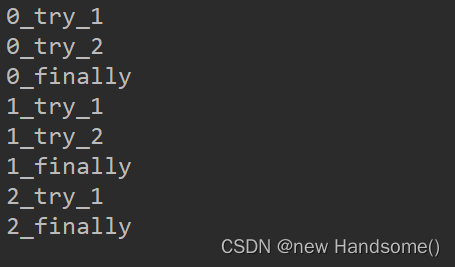
---
`思考下面代码的执行结果:`
public class FinallyTest {
public static void main(String[] args) {
// 3
// 77
// 11
System.out.println(t());
}
private static int t() {
try {
new Integer("好");
System.out.println(1);
return 2;
} catch (Exception e) {
System.out.println(3);
return 11;
} finally {
System.out.println(77);
}
}
}
## 四、throws 处理异常
### (1) throws
✒️ `throws`:**将异常抛给上层方法**
✒️ **main 方法**通过 throws 把异常抛给 JVM 后,程序会终止运行
✒️ 如果 throws 后面的异常类型存在父子关系,保留父类型即可
✒️ 可以一部分异常通过 try-catch 处理,一部分异常通过 throws 处理
---
public class ThrowsTest {
public static void main(String[] args) throws ClassNotFoundException {
// 通过 throws 把异常抛给 JVM
m1();
}
private static void m1() throws ClassNotFoundException {
// 通过 throws 把异常抛给上层方法
m2();
}
private static void m2() throws ClassNotFoundException {
// 通过 throws 把异常抛给上层方法
m3();
}
private static void m3() throws ClassNotFoundException {
// 通过 throws 把异常抛给上层方法
Class.forName("com.oracle.gq.Hello.java");
}
}
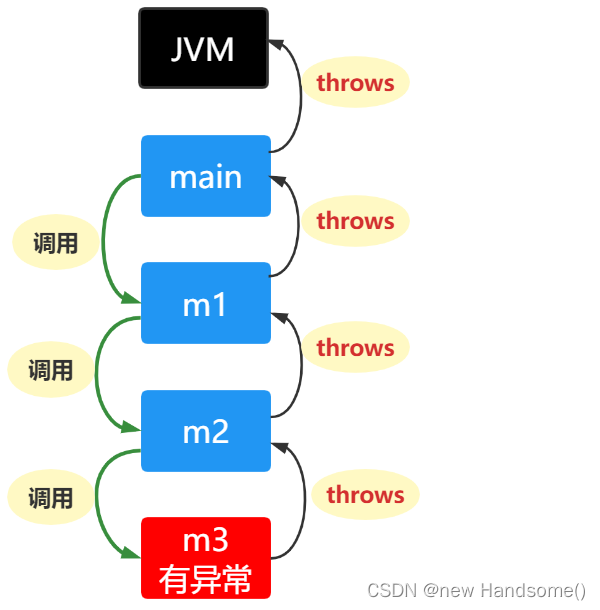
### (2) throws 细节
✒️ 有继承关系的时候,子类重写父类的方法抛出的异常不能大于父类方法抛出的异常(必须是父类方法抛出的异常的子类型)
✒️ 父类方法 throws 了异常,子类重写父类的方法可以不 throws 异常
✒️ 父类方法没有 throws 异常,则子类重写父类的方法一定不能 throws 异常
public class Person {
public void test1() {
}
public void test2() throws IOException {
}
public void test3() throws IOException {
}
public void test4() throws IOException {
}
}
class Student extends Person {
// 父类的 test1 没有 throws 异常, 则子类重写父类的 test1 也不能 throws 异常
@Override
public void test1() {
}
// 父类的 test2 有 throws 异常, 但子类重写父类的 test2 可以不 throws 异常
@Override
public void test2() {
}
// 父类的 test3 抛出了 IOException 异常, 子类重写父类的 test3 可以抛出和父类一样的异常
@Override
public void test3() throws IOException {
}
// 父类的 test4 抛出了 IOException 异常, 子类重写父类的 test4 可以抛出父类异常的子异常
@Override
public void test4() throws FileNotFoundException {
}
}
## 五、throw 主动抛出异常
📜 使用`throw`可以抛出一个新建的异常
>
> 🌼 问题比较严重的时候抛出**检查型异常**
> 🌼 问题不哪么严重的时候抛出**非检查型异常**
>
>
>
public class Person {
public Person(String name) throws Exception {
if (name == null || “”.equals(name))
// Exception 是检查型异常
throw new Exception(“name must not be empty.”);
}
}
class Student {
public Student(String name) {
if (name == null || name.length() == 0)
// IllegalArgumentException 是非检查型异常
throw new IllegalArgumentException(“name must not be empty”);
}
}
## 六、自定义异常
### (1) 自定义检查型异常
📖 若希望开发者重视这个异常、认真处理这个异常,则自定义**检查型异常**
📖 创建一个**类**(异常类),并继承 `Exception` 即可创建一个**自定义的检查型异常**
📖 检查型异常使用起来比较麻烦(相对非检查型异常来说)
/**
* @author 庆医
* @describe 自定义检查型异常
*/
public class EmptyNameException extends Exception {
public EmptyNameException() {
super(“name must not be empty!”);
}
}
---
### (2) 自定义非检查型异常
📖 若不严格要求开发者去处理这个异常,则定义为**非检查型异常**
📖 从创建一个**类**(异常类),并继承 `RuntimeException` 即可创建一个**自定义的非检查型异常**
/**
* @author 庆医
* @describe 自定义非检查型异常
*/
public class IllegalAgeException extends RuntimeException {
public IllegalAgeException(int age) {
super(“The age you provided is " + age + " [年龄必须大于零]”);
}
}
---
`使用自定义异常:`
public class Person {
private int age;
private String name;
public Person(String name) throws EmptyNameException {
if (name == null || "".equals(name))
throw new EmptyNameException();
this.name = name;
}
public Person(int age) {
if (age < 1) {
throw new IllegalAgeException(age);
}
this.age = age;
}
}
## 七、使用异常的好处
🔑 将错误处理代码和普通代码区分开
🔑 可以将错误信息传播到调用堆栈中
🔑 可以对错误类型进行区分和分组
## 八、案例(编写断言类)
📖 断言(assertion)作用:验证软件开发者对某一功能预期的结果
>
> 🌼 当程序执行到**断言**的位置时,会对软件开发者希望测试的功能进行测试。若断言不为真,程序会**中止执行**(抛异常);若断言为真,不会抛异常,直接往后执行。
>
>
>
>
> 🌼 **下面的代码**实现了一个简单的计算器类
> 🌼 用于计算两个数的和,和计算两个数的商
> 🌼 当计算两个数的商的时候,必须保证第二个参数不为零(在此自定义异常类 DivideException 对第二个参数进行校验)
> 🌼 考虑到 DivideException 异常类可能只在本类中使用,不会被其他地方复用,所以把它定义为静态嵌套类
> 🌼 博主认为除法运行的时候第二个参数若为零的话会非常严重,所以把 DivideException 定义为了**检查型异常**
>
>
>
/**
* @author 庆医
* @describe 简单计算器(用于测试断言类、静态嵌套类、自定义异常)
*/
public class SimpleCalculator {
private static int sum(int n1, int n2) {
return n1 + n2;
}
private static double divide(double n1, double n2) throws DivideException {
if (n2 == 0) throw new DivideException();
return n1 / n2;
}



既有适合小白学习的零基础资料,也有适合3年以上经验的小伙伴深入学习提升的进阶课程,涵盖了95%以上大数据知识点,真正体系化!
由于文件比较多,这里只是将部分目录截图出来,全套包含大厂面经、学习笔记、源码讲义、实战项目、大纲路线、讲解视频,并且后续会持续更新
主认为除法运行的时候第二个参数若为零的话会非常严重,所以把 DivideException 定义为了检查型异常
/\*\*
\* @author 庆医
\* @describe 简单计算器(用于测试断言类、静态嵌套类、自定义异常)
\*/
public class SimpleCalculator {
private static int sum(int n1, int n2) {
return n1 + n2;
}
private static double divide(double n1, double n2) throws DivideException {
if (n2 == 0) throw new DivideException();
return n1 / n2;
}
[外链图片转存中...(img-p1Xdme65-1715316781981)]
[外链图片转存中...(img-bwiu5UP0-1715316781982)]
[外链图片转存中...(img-UF5bZB9z-1715316781982)]
**既有适合小白学习的零基础资料,也有适合3年以上经验的小伙伴深入学习提升的进阶课程,涵盖了95%以上大数据知识点,真正体系化!**
**由于文件比较多,这里只是将部分目录截图出来,全套包含大厂面经、学习笔记、源码讲义、实战项目、大纲路线、讲解视频,并且后续会持续更新**
**[需要这份系统化资料的朋友,可以戳这里获取](https://bbs.csdn.net/forums/4f45ff00ff254613a03fab5e56a57acb)**






















 849
849

 被折叠的 条评论
为什么被折叠?
被折叠的 条评论
为什么被折叠?








